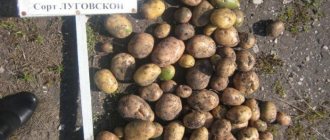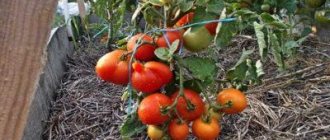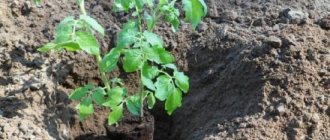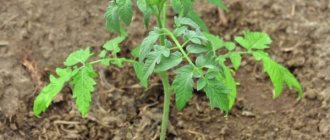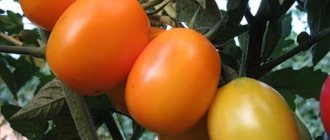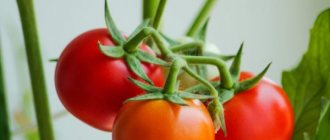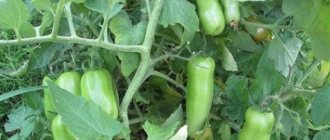» Vegetable growing » Tomatoes » Varietal features of the Flyashen tomato
0
1039
Article rating
German breeders have developed a new variety based on the Corianne F1 hybrid. The Flyashen tomato received its name due to its shape, which resembles a bottle. The variety is distinguished for its extreme yield, resistance to pathogenic microorganisms and ability to bear fruit before the first frost.
- Advantages and disadvantages of the variety
- Growing
- Sowing time for seedlings
- Preparing seeds and soil
- Sowing scheme
- Transfer
- Care
- Watering
- Feeding
- Disease and pest control
- Reviews from gardeners
Varietal characteristics of tomato Flyashen
Brief information about the variety
- Fruits and bush : pepper-shaped tomato, length – 6-9 cm, weight – 40-60 g. Bush is indeterminate, average height – 2 m.
- Productivity : 6-7 kg per bush.
- Resistance : the variety is resistant to frost and most known diseases, especially late blight.
- Distribution : planting in open ground - southern and central regions, greenhouse - northern.
- Application : fresh, canned and dried, ketchups, sauces.
- Planting : seedling method, 4-6 bushes per 1 m².
- Soil : humus with turf soil.
- Care : watering - as the soil dries. Fertilizers - weekly (mineral or organic), preparations containing calcium are required (when planting). The culture requires pinching and tying.
- Ripening period : mid-season variety, 110-120 days after the appearance of the first shoots.
How to grow the Flyashen variety
Seeds are sown in early March. Before sowing, the seeds should be pre-soaked in a growth stimulator. This process will make it possible to determine the germination of seeds and transplant them into a separate container, so that in the future the seedlings can be transferred to a larger container. As soon as the seedlings appear, they should be removed to a cooler place, with more light. After The seedlings will have 2 true leaves; they should be transplanted into cups up to 0.5 liters in volume.
It is important to know: Due to the fact that the plant is afraid of blossom end rot, it should be fed with a calcium preparation from the first month of planting.
The drug Brexil Ca is perfect for this; it contains boron, as well as other necessary substances for the full development of the plant. Don’t forget, blossom end rot is caused by the hot sun and insufficient or uneven watering. When planting seedlings in the ground, you should not plant more than four bushes per square meter.
The tomato variety "Flyashentomaten" is quite easy to grow. As mentioned above, it is suitable for both growing in a greenhouse and in open ground.
Many experienced gardeners strongly recommend soaking the seeds for half a day before planting until they swell for better growth. 500 milliliter containers are perfect for primary seedlings.
Important! Never allow the soil to become waterlogged.
The “Flyashentomaten” bush is quite tall, and on the branches the fruits are arranged in clusters of several pieces. In this regard, it is necessary to tie it to a support, otherwise it may fall from the slightest gust of wind. It is recommended to grow the bush with one, maximum two stems. You will also need to prun the bush.
You should water abundantly, but be sure to monitor the weather. If the summer was not very hot, then you should not moisten the soil too much. In hot weather, watering should be done every two or three days (depending on temperature and humidity level).
This variety is very resistant to most types of diseases. Many recommend preventive treatment of seeds against fungal and viral diseases. Like many other plants, “Flyashentomaten” is susceptible to such a destructive disease as late blight. If you have discovered signs of this infection, then the first thing you need to do is reduce the amount of watering, and also ventilate the bushes if they grow in greenhouse conditions.
We should not forget about fertilizing the bush. In order for it to produce maximum yield, fertilizers with a high content of potassium and calcium will be required. Both of these substances stimulate the growth of the bush and also protect it from many diseases.
Characteristics of the variety
Flyashentomat is a variety that includes several varieties of tomatoes. Due to recent breeding, the variety has not yet matured, so the shape of the fruits and bushes may differ slightly from that stated in the description.
In the breeding community, pepper-shaped tomatoes have gained popularity due to their increased fruiting and dense flesh. The main difference from other varieties is the formation and ripening of fruits before the onset of the first frost.
Bushes
The tomato bush is classified as indeterminate, because it grows up to 2-3 m with good care. The plant is tall, compact, medium-leafed, with a thin stem. The brushes are large and form several dozen fruits at a time.
Fruit
The tomato gets its name from its elongated fruits that resemble a bottle in appearance. Sometimes tomatoes have a slight elongation at the tip (spout), and in some specimens it is absent.
The fruits are small: their length does not exceed 9 cm, and their weight ranges from 40 to 60 g. When unripe, the tomatoes are light green in color; when they reach ripeness, they turn red. The skin is dense, with a glossy tint, and the flesh is fleshy and juicy.
Productivity and fruiting
Tomato Flyashen is classified as a mid-season variety with a ripening period of 110-120 days from the appearance of the first shoots. This time directly depends on the climatic characteristics of the growing region. Fruits reach ripeness faster in warm and sunny weather. Cold, cloudy summers will reduce the amount of harvest and increase the ripening period.
Favorable climatic conditions and compliance with care rules increase fruiting. The yield of the variety is high: 6-7 kg of fruits are collected from one bush. In greenhouse conditions, you can extend the fruiting period and increase the amount of harvest.
Resistance to diseases and pests
Hybrid tomato bushes are immune to most known diseases caused by fungal spores and infectious pathogens. The main advantage of the tomato is its resistance to late blight, which affects almost all varieties of nightshades.
Variability of weather conditions can lead to a temporary stop in the growing season or death of the plant. Tomato Flyashen is capable of full recovery after weather disasters.
Area of application of fruits
The unique appearance of the fruit and their taste characteristics have added to the variety’s popularity in the vegetable market. Abundant fruiting and resistance to transportation have made tomatoes a profitable commodity for commercial cultivation.
Thanks to their interesting shape, tomatoes are great for winter preparations. Their bright taste makes them an ideal raw material for making ketchups, juices and sauces. In summer, tomatoes are added to salads.
Description of tomato Flyashen
The tomato variety is classified as an indeterminate type: taking into account the growing conditions, the tomato can grow up to 2 m. The bush is distinguished by thin but strong shoots. The plant is not particularly spreading.
The leaf blades are medium in size, located on the shoots in small quantities. This feature allows for full access of sunlight to the fruits for timely ripening. The inflorescences are simple.
Important! The Flyashen tomato variety is demanding when it comes to pruning and staking; pinching is a must.
The choice of method for forming a bush (1 or 2 shoots) depends on the cultivation conditions.
Description of fruits
The variety is known among gardeners due to its productivity and taste characteristics. Description of the tomato variety Flyashen: a pepper-shaped fruit with a small spout at the end.
Some vegetables may have a depression instead of a shoot. This feature is due to the fact that the tomato variety has not fully stabilized, so it is partially similar in appearance to its parent.
The size of the Flyashen tomato is relatively small: the variety is slightly larger than a cherry. The length of the fruit is 6-9 cm, weight ranges from 40 to 60 g.
Ripe tomatoes have a red hue, the skin is thick and glossy. The fruits of the Flyashen variety are characterized by very juicy and dense pulp, a rich sweet taste and a pronounced aroma. Tomatoes contain a large amount of dry matter. They do not crack and withstand long-term transportation well.
According to the description and characteristics of Flyashentomaten tomatoes, the fruits have very few seeds, and they are surrounded by pulp, similar in consistency to jelly. This makes it difficult to collect seed, so it is preferable to grow tomatoes by rooting shoots.
Advantages and disadvantages of the variety
Tomatoes all season
Description of the positive characteristics of the variety:
- long fruiting period (until frost);
- high level of productivity;
- extraordinary appearance of the fruit;
- disease resistance;
- rich taste of tomatoes;
- long storage period;
- good transport tolerance.
The main disadvantages of the variety include a predisposition to blossom end rot, which occurs due to improper watering. Lack of heat and sunlight slows down the ripening process of fruits, which can affect their quantity and quality.
():
Blossom rot is a non-infectious disease that occurs due to a lack of calcium in plants. Calcium deficiency can result from high doses of nitrogen fertilizers, which displace calcium from the soil solution. In hot conditions, with soil temperatures above +30 degrees, tomato roots stop absorbing calcium (although it may be in sufficient quantities in the soil). Tomato varieties with an elongated fruit shape are prone to blossom end rot.
What complicates the care activities is the crop’s demands on pinching and tying, which is associated with the large height of the bush.
Features of agricultural technology
The seedling period begins in March. There are few seeds, so such valuable material must be carefully prepared. After mandatory selection, the floating seeds are set aside and work continues with the remaining ones.
Attention! Prevention of blossom end rot is recommended from the very beginning. Immunity will be strengthened by feeding with preparations containing calcium. Seedlings can be placed in the beds quite densely - up to 3 bushes
It is necessary to consider a support system before the plantings grow. Close planting leads to insufficient ventilation of the stems and excess moisture accumulates. As a result, the risk of disease increases significantly
You can place seedlings in the beds quite densely - up to 3 bushes. It is necessary to consider a support system before the plantings grow. Close planting leads to insufficient ventilation of the stems and excess moisture accumulates. As a result, the risk of disease increases significantly.
Tomato needs weekly feeding. Both mineral and organic formulations are suitable. The latter can be used until the first collection. In case of insufficient lighting or in cool weather, growth does not stop; the fruits are still formed and filled. However, all processes proceed more slowly; the gardener risks being left with a large number of unripe tomatoes by autumn.
To obtain a high-quality harvest, it is important to ensure that the balance of nutrients in the soil is maintained. Tomato fruits much more actively on the sunny side of the garden
Growing
Productivity depends on the quality of planting material and compliance with care requirements. You need to buy seeds only from a trusted company that has certificates confirming their quality.
In addition to the accompanying documentation, it is worth checking the packaging, expiration date and description of the seeds. Failure to comply with storage rules leads to seed spoilage, dampness and damage by pathogenic microorganisms. The approaching expiration date indicates a decrease in seed germination.
Sowing time for seedlings
Seeds are sown at different times depending on the climatic characteristics of the area: in warm regions of the country, these dates fall in the first ten days of March, in the central and northern regions - early April.
The characteristics of the variety do not allow planting in open ground in cold regions, because the tomatoes will not have time to ripen. The average duration of seedling formation is 6-9 weeks, after which it is ready for transplanting.
It is worth correctly calculating the date of sowing seeds for seedlings.
Preparing seeds and soil
Seeds purchased in a specialized store are checked for germination. They are dipped into a container with saline solution and kept in it for 5 to 10 minutes. Material floating on the surface is removed, and seeds that have sunk to the bottom are prepared for sowing.
():
In a saline solution, seeds are divided into full-weight and puny. Full-weight seeds sink to the bottom, and puny seeds remain on the surface. Frail seeds can also be viable, but the low weight of these seeds means a small amount of reserve substances in the cotyledons. Because of this, seedlings may be weak and develop poorly.
The second mandatory stage of preparation is disinfection. Selected planting material is placed in a solution of potassium permanganate for 30 minutes to kill all pathogenic microorganisms.
Tomatoes require nutritious, loose soil, which can be purchased at the store or made independently. A suitable mixture is obtained by mixing turf soil and humus in equal proportions. The prepared soil is calcined in the oven or watered with a solution of potassium permanganate to eliminate the risk of seed contamination.
Sowing scheme
Nutritious soil is poured into a prepared container (box, glasses), furrows are made in it (1-1.5 cm deep) and the seeds are sown at a short distance from each other. The grooves are sprinkled with earth, moistened and covered with polyethylene to create greenhouse conditions.
When seedlings appear, the cover is removed and the container is moved to a well-lit windowsill. The optimal temperature level is at least 22-24 °C.
Watering is carried out as needed to prevent rotting of the seedlings. The seedlings are provided with good ventilation, but there should be no drafts. Picking into separate containers (peat glasses) is carried out when 2-3 true leaves are formed.
7-10 days before planting in open ground, seedlings are hardened. Every day, her time in the fresh air is increased from 2 to 24 hours.
Transfer
The area for tomato plantings should be well lit and protected from the wind. 2 weeks before planting the seedlings, it is dug up and fertilized. This can also be done during the planting process: mineral fertilizers (potassium, nitrogen) are added to the hole.
Seedlings are planted in heated soil, otherwise the plant may die. Holes are formed in the selected area taking into account the optimal placement pattern (4-6 bushes per 1 m²).
The planting description indicates that the seedlings should be lowered into the holes along with peat cups so as not to damage the root system. Then the holes are covered with earth and moistened abundantly.
Care
Many fruits on the bush
The characteristics of the Flyashen tomato indicate its demands on certain care rules that affect the abundance of fruiting. Support is provided for him, because... the variety will grow intensively. They resort to the help of trellises or wooden stakes that do not injure the stem.
Watering
Watering is carried out as the soil dries. High humidity provokes fungal diseases. In dry conditions, plantings can be hilled to retain moisture and develop an additional root system.
Flyashen needs light soil, so after each watering it is loosened and freed from weeds.
Feeding
The bushes are fed every week with mineral or organic supplements that promote abundant fruiting:
- urea. 0.2 kg of the substance is diluted with 10 liters of water. Water the plants with this mixture at the rate of 0.5 liters per bush;
- Diammophoska. The fertilizer contains nitrogen, phosphorus and potassium. 200 g of the substance is poured into 5 liters of water and applied at the root of the plant.
Gardeners also use the preparations “Ekost”, “Terracom”, “Apion”.
Disease and pest control
Tomatoes of this variety are classified as hybrids that are genetically resistant to most diseases of nightshade crops, but there are several pathologies, the development of which occurs due to non-compliance with care rules:
- top rot. The cause of its occurrence is considered to be a lack of calcium in the soil. The disease is identified by a characteristic dry spot on the underside of the fruit. As a preventative measure, plants are sprayed with calcium nitrate (20 g per 10 liters of water) 3-4 times per season;
- brown spot. Grayish formations on the leaves indicate the development of this disease. If you do not start timely treatment, the entire bush will die. A mixture of colloidal sulfur (3 tbsp), copper sulfate (1 tbsp) and polycarbacin (1 tbsp) helps eliminate the disease. It is diluted in 10 liters of water and added 2 tbsp. l. liquid soap.
Flyashen - tomato! Ideal variety for canning
Flashe tomaten
Sing "Firewood"
What is important to consider?
There are several points to consider when growing this variety:
- the plant always requires pinching, pruning and staking;
- measures must be taken to prevent the plant from becoming sick with blossom end rot;
- You always need to make sure that the tomatoes have enough light and heat, otherwise the fruits will take a long time to ripen.
In addition, you need to follow these recommendations if you decide to grow this variety:
- If you decide to use seeds, it is best to plant in March. Important! In order for germination to go better, it is recommended to pre-soak the seeds in special products that stimulate their growth.
- When the shoots have appeared, you will need to move the tomatoes to a place where there will be a lower temperature and a high degree of light.
- When the plant has its first large leaves, it can be transplanted into a larger pot. Important! To prevent the plant from getting sick with blossom end rot, it is necessary to flavor it with special products that contain calcium.
- When planting in the ground, you need to plant plants so that there are no more than 4 of them per square meter.
- During planting, you need to organize support pegs for the tomatoes (up to two meters high).
- This variety has a high yield rate, in order to achieve it, you need to add fertilizer every week. The last fertilizing should be done 35 days before the actual harvest.
Reviews from gardeners
Tomatoes are still little known in the country, but connoisseurs of exquisite varieties highlight flashentomat for its abundant yield and resistance to most known diseases.
Its unusual appearance, bright taste and resistance to transportation make it a worthy competitor to domestic tomatoes in the vegetable market.
The variety received positive reviews due to its dense, fleshy pulp, which is suitable for making sauces and juices. The dense skin is not prone to cracking, which preserves the taste and aesthetic qualities of winter preservation.
Sun-dried tomatoes can also be made if the household has a special machine for drying vegetables.

